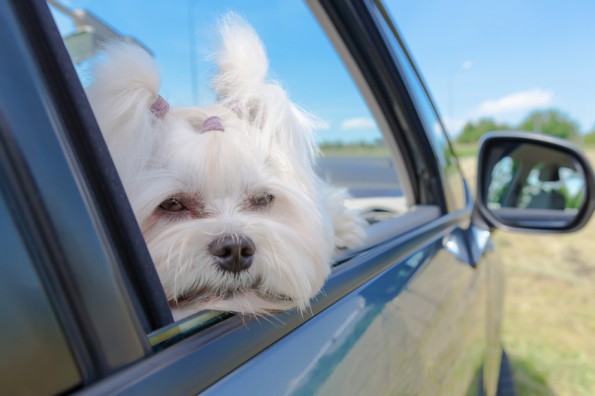As we head out of town for Thanksgiving, many of us don’t hesitate to bring our pets along for the ride. Next weekend, thousands of dogs will be jetting, ferrying and driving hundreds of miles across Canada in pursuit of their turkey dinner!
That’s no problem for the majority of dogs that are as excited to go for a car ride as they are for the feast that awaits them. But, getting travel-phobic pets from A to B without barking, whining, pacing and throwing up en route is already on many owners’ minds.
Nausea, anxiety and unruly behaviour on car journeys are common problems, affecting around 20 per cent of pet dogs. This equates not only to thousands of miserable animals, but more critically, a lot of distracted driving.
What can we do to ensure that we reach our destination relaxed, in one piece and without the car smelling of vomit? Many solutions are available, but which ones actually work?
The first step is to identify if and why your dog is distressed, as different causes require different treatments. As Thanksgiving weekend is only a week away, many owners will be relying on quick fixes.
If your dog experiences motion sickness, recognizable by hyper-salivation, retching, vomiting and sometimes diarrhea, a visit to your veterinarian to get an anti-nausea product is a good call. Currently, Cerenia is the only FDA-approved product for the treatment motion sickness in dogs, although your veterinarian may recommend other products instead, such as Gravol or Benadryl. Some anti-nausea medications also sedate, so your veterinarian will need to know what shape your dog needs to be in when it reaches its destination.
If you are planning to swing by the pharmacy on the way to the ferry terminal, bear in mind that not all anti-nausea products made for humans are safe for all pets, so check with your veterinarian first what and how much to give.
Even if an anti-nausea product is effective, some dogs continue to dread getting into the car, sometimes anticipating the nausea of journeys-past. Travel anxiety also occurs in dogs that have suffered a traumatic event in a vehicle, such as an accident, or that have shocked by an electronic collar as they pass through an ‘invisible fence’ at the perimeter of their property. Dogs that have not got used to car rides from a young age and puppies too are at a greater risk of having travel-related anxiety and nausea.
Anxious dogs behave in a variety of ways. Once having been lured or perhaps forced into the car, some pets develop a full-blown stress response. Keep an eye out for excessive salivation, panting, trembling and an elevated heart rate. Seeing your windows fog up and covered in slobber are telltale signs.
Some anxious dogs will also whine, whimper, pin their ears back and tuck their tails between their legs. Also, watch for dogs that raise their front paw, yawn and lick their lips frequently.
Anxious dogs require weeks, if not months, of ‘systematic desensitization training’ to eventually feel safe in their vehicle. This involves gradual exposure to being in a parked vehicle, being in a parked vehicle with the engine running, and eventually short, tolerable trips that end before a panic attack is underway. However, when time is of the essence, again there are band-aid products that can help to alleviate the discomfort for stressed pets.
Your veterinarian may prescribe an anti-anxiety medication or sedative to help your pet stay calm. But, these products do not always have the desired effect. Recall the child on the airplane bouncing off the cabin walls instead of sleeping soundly after a dose of Benadryl? Well, some dogs can show similar paradoxical effects to sedatives. For this reason, make time to test these medications in advance of your trip.
For owners who prefer to avoid medications, low-risk, non-prescription products are also available. However, peer-reviewed clinical studies suggest that their effect is slight, with some pets failing to respond at all.
DAP (Dog Appeasing Pheromone, available from your veterinary clinic) calms dogs without sedating them. But, when clinically tested, while some nauseas dogs improved, it had no significant impact on excitable dogs. Conversely, diffused lavender oil reduces dog activity during car rides, but has no proven effect on anxiety. In one clinical trial, dogs treated with lavender aromatherapy spent more time sitting or lying down quietly than a Control group.
The Thundershirt also claims to help calm anxious dogs during travel, although, a study published this year in the Journal of Veterinary Behaviour found that its effects were minimal. This body-hugging wrap had no significant effect on a dog’s heart rate or behaviour during transit, unless the dog was already on an anti-anxiety medication, in which case it helped a little.
To conclude, if your dog is distressed on car rides, prescription products work best. And, while non-prescription solutions can chip away at mild issues, they don’t provide as much value for money and have insufficient effect in more severe cases. So, if you can’t see your veterinarian in time for your trip, and the non-prescription items don’t quite cut it for your dog, try to stick to the highways — drivers can do their part by avoiding erratic movements, sharp turns and bumpy roads. Transporting your pet on an empty stomach can also help avert problems. Or, if all else fails, maybe think about having Thanksgiving at home with your dog this year!
By Dr. Rebecca Ledger, Special To the Sun
Rebecca Ledger is an animal behaviour scientist, and sees cats and dogs with behaviour problems on veterinary referral across the Lower Mainland.
Read article on The Vancouver Sun

